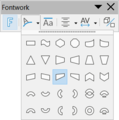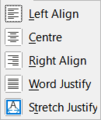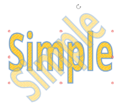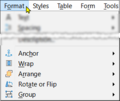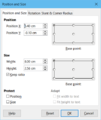Create and edit Fontwork
TDF LibreOffice Document Liberation Project Community Blogs Weblate Nextcloud Redmine Ask LibreOffice Donate
Foreword
The video shows the application "Create and edit Fontwork in LibreOffice" and links to this page here, which provides further information and details.
The basis of this description and the video is the Fontwork how-to article in TDF Wiki.
Link to the Video
Link to the Video (in German [DE]):
Create and edit Fontwork - LibreOffice
What is Fontwork?
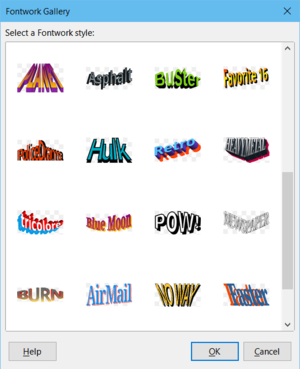
The Fontwork-Tool provides text in different fonts with special effects that are different from ordinary text.
From the Fontwork Gallery you can select graphic and artistic text objects to make your documents more attractive.
There is a wide range of pre-defined templates available, and you are sure to find the one that suits your document and adapt it as required.
Fontwork is available in the components Base, Calc, Draw, Impress and Writer.
The menu navigation is partly different in the components.
For this description Draw and Writer was used in part.
Fontwork Options
- Complete management of 3D effects
- Area with colour gradients, colours, patterns etc.
- Character size
- Character spacing etc.
How do I create a Fontwork object?
Display the Fontwork Gallery using one of these commands:
- Choose the menu ▸
- In the "Drawing" toolbar choose the "Fontwork" icon (for the toolbar choose the menu ▸ ▸
- In the Fontwork toolbar, select the Fontwork icon (for the toolbar, select the ▸ ▸ menu to display it).
The Fontwork Gallery dialog is now open, Figure 1.
Select a Fontwork style and click .
How do I edit a Fontwork object?
Selecting a Fontwork object
-
Figure 2: The seven handles and the detail point
-
Figure 3: Font cursiv
-
Figure 4: Font recursiv
Click with the left mouse button on a Fontwork object to select it.
A selected Fontwork object is surrounded by seven squares, called "handles", which allow you to resize it, and a grey dot, Figure 2.
The grey dot allows the letters to slide, cursive Figure 3 and recursive Figure 4.
Write the text for the Fontwork object
Double-click on the Fontwork object.
The existing text is displayed smaller again and the cursor flashes.
You can now replace the text.
Then simply click outside the object and the new text will be displayed.
Use of the "Fontwork" toolbar
-
Figure 5: "Fontwork" Toolbar
-
Figure 7: Selection of styles of Fontwork shapes
You have created a Fontwork object and want to change some of its attributes.
Make sure that the Fontwork toolbar is visible, Figure 5.
If it is not, choose the menu ▸ ▸ .
The various tools allow you to edit your Fontwork objects quickly and easily.
![]() Fontwork Shape
Allows you to change the shape of the object, Figure 7.
Fontwork Shape
Allows you to change the shape of the object, Figure 7.
![]() Fontwork letters with the same height
Changes the height of the characters in the object.
Fontwork letters with the same height
Changes the height of the characters in the object.
Switches between normal letter height and all letters of the same height (Figure 9),
(some characters are larger than others, e.g. capital letters, or some lower case letters such as f, h, l, etc.)

-
Figure 11: Submenu Alignment of the font
-
Figure 12: Submenu "Alignment StretchedJustify"
-
Figure 13: Stretched justification on two lines
-
Figure 14: Line breaks with the Enter key
![]() Alignment
Allows you to change the character orientation, Figure 11.
Alignment
Allows you to change the character orientation, Figure 11.
The alignment in the order of the menu: Left-aligned, centred, right-aligned, word by word Justification, stretched Justification.
Click on the entry with the last option of the sub-menu Stretched Justification (Figure 12), so that each line of the Fontwork object is filled in completely, as shown in Figure 13.
![]() Character spacing
Allows you to change the spacing and kerning of characters, Figure 15:.
Character spacing
Allows you to change the spacing and kerning of characters, Figure 15:.
Select the desired distance.
For custom distances, select "Adjust" in the sub-menu and enter a percentage value: 100% is the normal percentage. Below 100% the distance is reduced, above 100% the distance is increased.
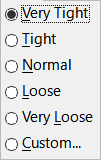
Use the "Drawing object properties" toolbar
For example, if you click on an existing Fontwork object in Writer, the "Formatting" toolbar is replaced by the "Drawing Object Properties" Toolbar to display additional font options.

This toolbar (Figure 16) gives you access to advanced functions for customising your Fontwork object.
- Click on a Fontwork shape. The "Drawing Object Properties" toolbar, and thus offers many alternatives for the appearance, in the Writer component.
- In the "Drawing Object Properties" toolbar, you have a whole range of tools to customize your object.
Line options

Line options can also be found in the "Drawing Object Properties" toolbar.
The selection contains Line tips, Line style and Line width, Line colour, Fill type selection and the Fill colour, see Figure 17.

You can also change the line options as follows:
- Right-click on the Fontwork object for a context menu or
- select ▸ ( Ctrl + F5 ) and select "Properties".
In this example the same text appears in a different colour and line width, see Figure 18.
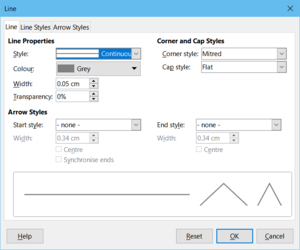
Select from the context menu.
The Line Dialog appears, Figure 19.
In the tab "Line" you can make the essential settings.
Fill options
-
Figure 20: "Properties" Sidebar
-
Figure 21: "Properties Filling type" Sidebar
Filling tool Use the Sidebar|Properties in Draw, Figure 20.
There you can set the filling and transparency.
In Fill you can select: None, Colour, Gradient, Hatching, Bitmap, and Pattern (Figure 21).
With these options you can fill in the letters of the Fontwork object.
-
Figure 22 - Examples of fills: a defined colour, shadow, transparency, bitmap and gradient
-
Figure 23: "Area|Area" Dialog Options
See some examples of fills in Draw with a defined colour, a shadow, with transparency, a bitmap and a gradient, Figure 22.
For the filling, select "Colour", "Gradient", "Hatching", "Bitmap/Image" or "Pattern" from the "Area" context menu and in the "Area" Dialog that opens to fill the letters of the selected object, Figure 23.
- Click "Enable" at "Shadow" and adjust parameters like angle, distance, colour and transparency to highlight the shadow of the object.
- At "Transparency" define a percentage degree of transparency that you want to apply to the selected object.
- With "Shadow|Colour", select from the available colours or add a new "Custom colour…" to the palette. This new colour is then available for all colour selections.
- Change the available colour gradients according to your wishes.
- At "Hatching" you can select the available hatching.
- Select an existing bitmap or import one to make it available.
- Or select an existing pattern.
To do this select ▸ ▸ from the menu.
New as of version 7.2 - Sidebar|Properties|Fontwork
Options for the position of font objects
-
Figure 24: Rotating a Fontwork object
-
Figure 25: Fontwork object with text pattern
-
Figure 26: Rotation Centre
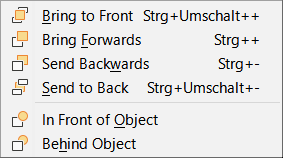
![]() Rotation angle tool
Allows you to manually rotate the selected object with the mouse, Figure 24.
Rotation angle tool
Allows you to manually rotate the selected object with the mouse, Figure 24.
Use the red handles surrounding the image and move the mouse in the direction you want to rotate.
By default the image is rotated around its centre (symbolised by a test pattern, Figure 25), but you can change the centre of rotation by moving it to the desired centre of rotation, Figure 26.
![]() Arrangement Tool
Allows you to arrange your graphic object so that you can determine its layer position relative to other graphic objects (rarely used for Fontwork objects) or text.
Arrangement Tool
Allows you to arrange your graphic object so that you can determine its layer position relative to other graphic objects (rarely used for Fontwork objects) or text.
This tool has six icons, Figure 27.
- All the way forward: Places the selected object above any other image or text.
- Forward: Places the selected object one level higher in the stack. Depending on the number of overlapping objects it is necessary to click on this symbol several times to get the desired result.
- To the back: Move the selected object one level lower in the stack of objects.
- All the way back: Move the selected object all the way back in the stack so that the other objects or the text covers it.
- In the foreground: Places the selected object in front of the text.
- In the background: Places the selected object behind the text.
![]() Anchoring
Allows you to change the object anchoring so that you can anchor Fontwork objects as characters or in a page, paragraph or character:
Anchoring
Allows you to change the object anchoring so that you can anchor Fontwork objects as characters or in a page, paragraph or character:
On the side: The object keeps the same position in relation to the edges of the page. It will not move even if you add or delete text or other objects such as images.
At the paragraph: The object is connected to a paragraph and moves with it. It can be placed at the edge or at another location.
At the character: The object is connected to a character, but not a text sequence. It moves with the paragraph and can be placed at the edge or elsewhere (this method is similar to anchoring the paragraph, but it cannot be used with drawing objects).
As character: the object is placed in the document like any other character that affects the height of the text line and the line break.
The object moves with the paragraph when you add or delete text before the latter.
![]() Group
Allows you to group the selected objects so that you can manage them as a single object.
Group
Allows you to group the selected objects so that you can manage them as a single object.
-
Figure 33: "Format" Menu
-
Figure 34:Context Menu Fontwork
-
Figure 35: "Position and Size" Dialog box
![]() Ungroup
Allows you to separate the selected objects so that you can manage them individually.
Ungroup
Allows you to separate the selected objects so that you can manage them individually.
You can select some of the options described in the previous sections from the menu (Figure 33) to anchor, arrange, mirror horizontally and vertically, rotate and group selected Fontwork objects.
You can also right-click on a Fontwork object to get most options in a shortcut menu, Figure 34.
In fact, this context menu provides quick access to tools such as , , and so on.
On the other hand, the Context menu (like the menu) offers the entry Position and Size, shortcut F4 (in the components Draw and Impress).
These open the Dialog Position and Size, Figure 35, in which you can specify exact values for the size and position of the selected Fontwork object.
How can I change the size of a Fontwork object and move it?
Change the size of a Fontwork object
Using the mouse
When you select a Fontwork object, eight square handles are visible around the object.
Click and drag one of these handles (except the grey dot) to resize the object.
Once the object is selected, select one of these commands:
- choose the context menu in Writer or ▸ ▸ in Impress
- Right-click to open the context menu and choose in Draw
- Press F4 (in Draw or Imprint).
In the tab Position and size:
- select the tab Position and Size
- if necessary, check the box "Keep aspect ratio".
- enter the desired values for the width and height of the object.
- confirm with .
Change the font size of letters
When selecting a Fontwork object, you can hold one of the corner points with the mouse and drag to reduce or enlarge the letters within the Fontwork object.
Move Fontwork object
To move the object within your document:
- mark the Fontwork object.
- move the Mouse pointer over the text to see the cursor like this
 .
. - click and drag the fontwork to the desired position and release.
How can I change the font of a fontwork object?
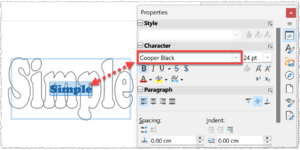
To change the font of a Fontwork object
Double-click the fontwork object.
The changeable font is displayed inside the object.
Select the inner font.
Select the font in the sidebar ( Ctrl + F5 ) at Properties.
Further Informations
Comparison between Fontwork and Microsoft Word © / WordArt ©
The Fontwork tool is similar to the WordArt © used in Microsoft Word ©.
When LibreOffice saves documents in Microsoft Office © format, each Fontwork object is converted to WordArt ©.
Documentation / Manuals
Here you will find the Documentation / Manuals:
Any questions?
For questions on this topic go to:
Get Involved
Join us today and help us to make it even better!
Donate
LibreOffice is Free Software and is made available free of charge.
Your donation, which is purely optional, supports our worldwide community.
If you like the software, please consider a Donation.



